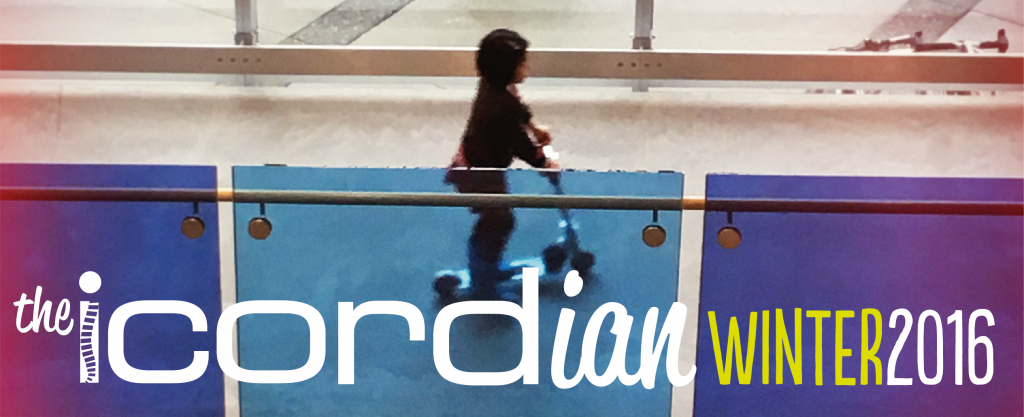
 In this issue, we invite you to our upcoming community research meeting, give you the scoop on some interesting research projects, and tell you a love story. Plus: an update on a story we brought you last Spring, and lots of news from our partners.
In this issue, we invite you to our upcoming community research meeting, give you the scoop on some interesting research projects, and tell you a love story. Plus: an update on a story we brought you last Spring, and lots of news from our partners.
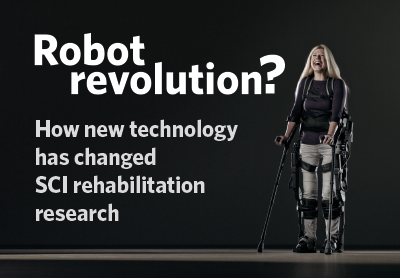 Join ICORD researchers & special guests for a casual dinner and informal discussion about current research into the use of exoskeletons for SCI rehabilitation.
Join ICORD researchers & special guests for a casual dinner and informal discussion about current research into the use of exoskeletons for SCI rehabilitation.
Monday 7 March at the Blusson Spinal Cord Centre
Dinner & displays: 6:00
Talks & discussion: 6:45 to 8:30
No charge • everyone welcome • Registration required: click here!
Presented as part of ICORD’s 2016 Annual Research Meeting & supported by the Rick Hansen Foundation through the Blusson Integrated Cures Partnership
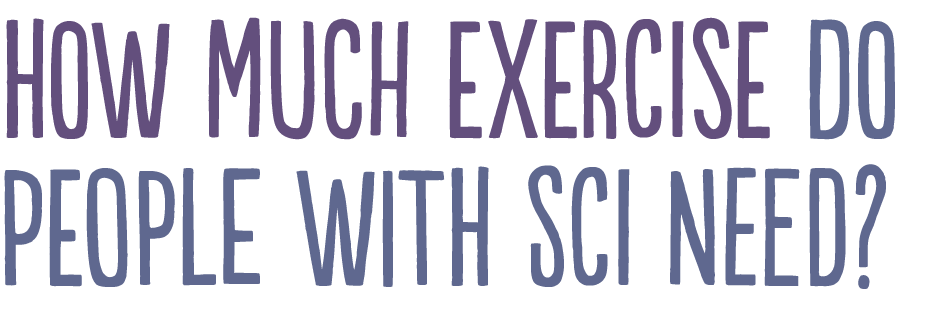 February is Heart Month, and it serves as an important reminder that the risk of cardiovascular disease (CVD) increases greatly for people with SCI.
February is Heart Month, and it serves as an important reminder that the risk of cardiovascular disease (CVD) increases greatly for people with SCI.
Understanding the effects of CVD is one of the research focuses of ICORD Principal Investigator Dr. Christopher West, who is studying the relationship between physical activity and CVD in people with SCI, a project funded by the Heart & Stroke Foundation.
While common guidelines hold that two and a half hours of moderate to vigorous activity per week for able-bodied people improves heart health, there are no scientifically based guidelines that relate physical activity to CVD risk in SCI, despite heart disease being the leading cause of death in those with SCI. Dr. West hopes this study will be the first steps towards creating standardized recommendations.
“No one really understands how much physical activity people with SCI get. We haven’t had a good way to measure it,” says Dr. West.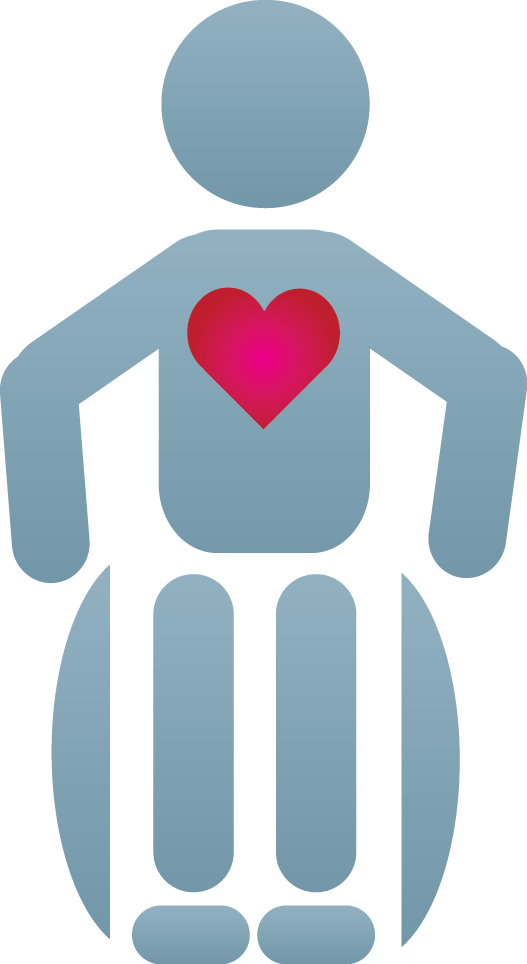
Previously, most information on the daily amounts of physical activity of people with SCI came from self-reporting, which can be unreliable. Dr. West and his team are devising more accurate methods to measure intensities and amounts of moderate to vigorous activity.
“We ask participants to wear accelerometers on their wrists and to push on a treadmill,” explains Dr. West. “We then measure the relationship between the accelerometer output and how much energy they expend.”
Participants are then outfitted with accelerometers, the same device in smartphones that determines if you’re holding the phone sideways or upright, and GPS trackers. The devices track a variety of different types of movements for one week, and the researchers then use the data collected in the lab to quantify how much and what levels of physical activity happened in that time.
This data will also be correlated with ultrasound testing of the study participants’ overall CV health, which will be crucial for determining how physical activity affects the heart health of people with SCI.
“We know that physical activity is important for our health and decreasing CVD risk, but we don’t know how much physical activity is needed for reducing the risk in people with SCI,” says Laura McCracken, the Master’s student and ICORD trainee who is leading much of the research as part of her thesis.
Many SCIs pose a significant danger to cardiovascular health, because they can damage the sympathetic nervous system, the system that regulates heart function.
At this point, there is no reason to believe that exercise won’t have the same benefits for those with SCI as it does in able-bodied people, but it’s unclear whether those benefits can be achieved with day-to-day moderate to vigorous physical activity or if more structured exercise will be necessary. This research will hopefully help answer that question.
Regardless of the results, regular physical activity should become part of anyone’s routine. “Physical activity is likely to have a myriad of other benefits including positive socio-cultural effects. So there’s definitely benefits outside of cardiovascular health,” says Dr. West.
The study is currently ongoing, and 16 people, ranging from highly trained athletes to community members with varying levels of spine injury, have so far participated. Dr. West and McCracken will be looking for more participants as new rounds of data collection start this spring. If you’re interested in joining the study, you can contact Laura McCracken.
For ICORD, this type of help from the SCI community is immeasurable.
“Studies would be impossible without people participating,” says McCracken. “We can come up with an idea for something that we think needs to be examined, but we can’t get too far if people aren’t willing to participate.”
 “I understand the importance of research. Getting involved is really valuable,” says Russ Dolton (left), who recently participated in an ongoing study to evaluate and develop a mobile app for people who have experienced a spinal cord injury.
“I understand the importance of research. Getting involved is really valuable,” says Russ Dolton (left), who recently participated in an ongoing study to evaluate and develop a mobile app for people who have experienced a spinal cord injury.
The project, funded by the Rick Hansen Institute, is being led by ICORD Principal Investigators Drs. Patricia Mills, Ben Mortensen, and Bonita Sawatzky, and it ties in closely with ICORD’s community-based research efforts.
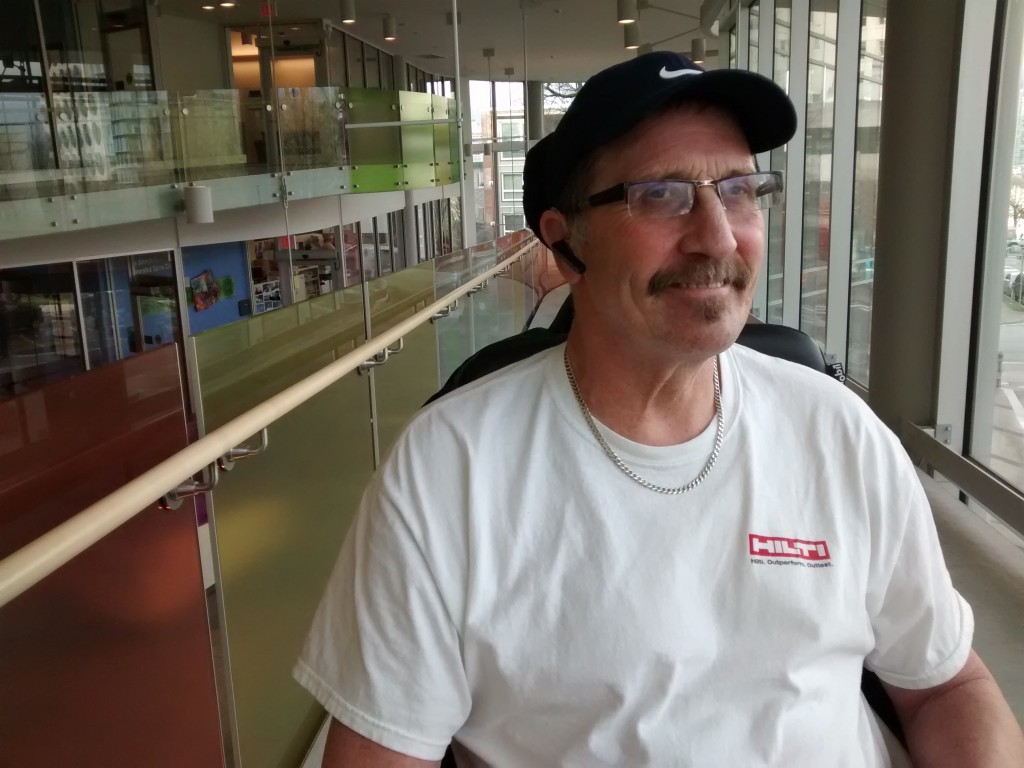 The app offers people with SCI a way to record health data, track progress, and access informational resources. The hope is that the app could become a useful tool for patients and clinicians in managing their health over time and preventing secondary complications.
The app offers people with SCI a way to record health data, track progress, and access informational resources. The hope is that the app could become a useful tool for patients and clinicians in managing their health over time and preventing secondary complications.
Russ was injured last summer and started the study only a few weeks after being admitted to the GF Strong Rehabilitation Centre.
“One part of this research is to know if this app is feasible at the acute stages of rehab,” says Dr. Mahsa Sadeghi, one of the study’s research coordinators. “That’s why we reach out to people only two weeks after getting to GF.”
Russ was particularly encouraged by the journaling tool in the app, which allowed him to go back and see his incremental improvements whenever he felt frustrated with his progress. Since the beginning of the study, he has had some success with his rehabilitation, regaining motor skills and adapting to his injury.
He was also happy to give input and help improve the app. He brought up issues with the user-friendliness of the interface and made suggestions on how it could be improved. “In the end, it was a really useful tool,” says Russ.
Russ hopes that his peers in the SCI community will help spread the word about getting involved in research.
If you’re interested in participating in this study, please contact Mahsa Sadeghi.

We’re happy to announce that the Community Resource Centre in the BSCC Atrium is now open from 10 A.M. to 4 P.M. every weekday except Wednesdays (when it closes at 2 P.M.). Next time you’re in the building, be sure to stop by, meet some of our friendly volunteers, and find out how you can participate in a research study!

 ICORD Trainee Greg Pearcey has won the prestigious Endeavour Research Fellowship, which will take him to Australia to study mechanisms within the central nervous system responsible for the control of voluntary movement. During his fellowship, Greg will be working closely with Dr. Timothy Carroll, an associate professor in the School of Human Movement and Nutrition Sciences at the University of Queensland.
ICORD Trainee Greg Pearcey has won the prestigious Endeavour Research Fellowship, which will take him to Australia to study mechanisms within the central nervous system responsible for the control of voluntary movement. During his fellowship, Greg will be working closely with Dr. Timothy Carroll, an associate professor in the School of Human Movement and Nutrition Sciences at the University of Queensland.
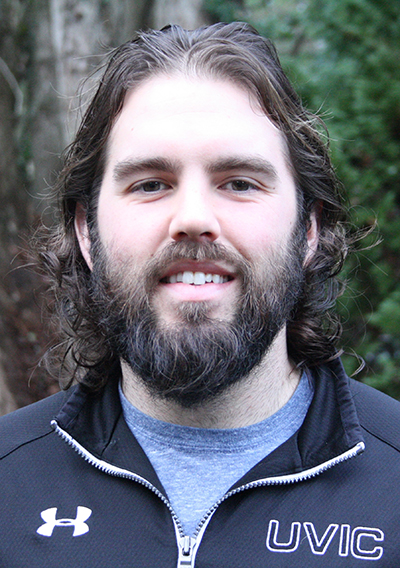 Greg, a PhD student in Dr. Paul Zehr’s lab at the University of Victoria, will examine the neural processes behind sensory motor adaptation. “Imagine if you were walking on ice and slipped,” says Greg. “What kind of correction does your brain make to keep you from falling?” The ICORD trainee wants to know how the brain reacts to such “errors” as expecting a foot will land on solid ground when it actually steps on a slippery surface.
Greg, a PhD student in Dr. Paul Zehr’s lab at the University of Victoria, will examine the neural processes behind sensory motor adaptation. “Imagine if you were walking on ice and slipped,” says Greg. “What kind of correction does your brain make to keep you from falling?” The ICORD trainee wants to know how the brain reacts to such “errors” as expecting a foot will land on solid ground when it actually steps on a slippery surface.
Understanding how the brain compensates and adapts during those tasks is particularly important to people who wish to regain motor function after a spinal cord injury or stroke, and it will also have relevance to those with Multiple Sclerosis, cerebral palsy, Parkinson’s disease, and other neurological issues that affect movement.
The Endeavour Fellowship is funded by the Australian government and helps build academic connections throughout the globe. For Greg, it allows him access to Dr. Carroll’s expertise and resources in Queensland. Some of Dr. Carroll’s more recent work has involved computational neuroscience and the use of such techniques as electromyography and electroencephalography, methods of measuring electrical activity in the muscles and brain, respectively, which Greg will be using for this project.
Dr. Carroll has also worked with ICORD Principal Investigator Dr. Zehr, who will be a co-author on the resulting paper from this fellowship. “This is facilitating an international collaboration between the University of Victoria and the University of Queensland,” says Greg.
He hopes other trainees will make contacts with scholars around the world to look for these kinds of opportunities, and he recommends doing it as early as possible. “I think it’s a great chance to diversify cultural and professional experience in other countries,” says Greg. He will arrive in Australia in February and stay into the summer (Australia’s winter).
 ICORD Principal Investigator Dr. Carolyn Sparrey recently completed a study of wheelchair falls in partnership with the B.C.-based start-up company MobiSafe Systems Inc. The Assistant Professor at Simon Fraser University wanted to assess the viability of airbags as a safety feature for wheelchairs.
ICORD Principal Investigator Dr. Carolyn Sparrey recently completed a study of wheelchair falls in partnership with the B.C.-based start-up company MobiSafe Systems Inc. The Assistant Professor at Simon Fraser University wanted to assess the viability of airbags as a safety feature for wheelchairs.
“The big questions are when someone falls, what kind of impact forces are they looking at? Where are they going to fall? How does the nature of the environment affect their fall?” she says.
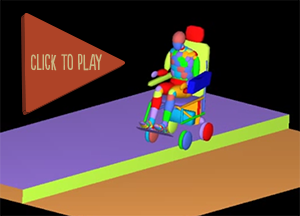 Dr. Sparrey and her team used crash-test dummies and computer simulations with powered wheelchairs to answer these questions. They remotely drove chairs off of curbs of different heights at varying angles and observed how a rider would fall in each scenario.
Dr. Sparrey and her team used crash-test dummies and computer simulations with powered wheelchairs to answer these questions. They remotely drove chairs off of curbs of different heights at varying angles and observed how a rider would fall in each scenario.
“The major finding was that using a seat belt in the wheelchair reduces head-impact forces significantly—almost an order of magnitude less,” says Dr. Sparrey.
The less severe impacts have to do with the large size power wheelchairs. If a user is belted in, then when the chair tips, the chair will absorb much of the force. Should a person fall out of the chair, however, he or she would take the brunt of the impact force. An “eye-opener” was that power wheelchair users were at risk of traumatic brain injuries from rolling off a curb of 40 centimetres at a bad angle, according to Dr. Sparrey.
The study also revealed that one of the most dangerous situations was when a wheelchair rolled of a curb at a shallow angle. This could result in sideways tipping. In more head-on approaches to a curb if the crash-test dummy wasn’t belted in, then it would be ejected from the chair.
While a seat belt can lower the risk of serious head injuries, there are ethical and legal implications of seat belts. The seat belts may act as restraints for users who do not have the dexterity to open the belts, and they can also contribute to pressure sores.
A survey of American veterans with spinal cord injuries found that nearly a third had fallen from their wheelchairs at least once in the past year. Some estimates say that 87 per cent of wheelchair users have fallen in the over the past three years. “It’s a big problem,” says Dr. Sparrey. “And there’s a lot to figure out.”
The results from this study are part of research and development of a wheelchair airbag designed by Mobisafe Systems, a wheelchair safety-device company founded by Dr. Sparrey’s SFU colleague Dr. Siamak Arzanpour.
Dr. Sparrey’s study will be published in the Journal of NeuroEngineering and Rehabilitation this year, and she’ll be commencing a similar study on manual wheelchairs with her ICORD colleague Dr. Jaimie Borisoff and the B.C. wheelchair company PDG Mobility.

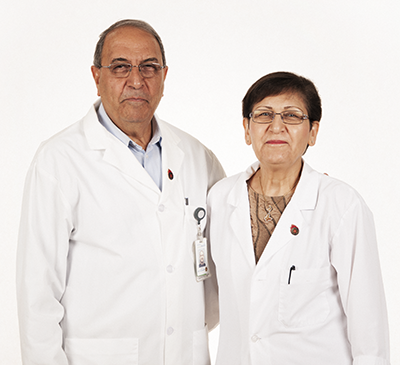 Dr. Aziz Ghahary is known for groundbreaking research in the lab, but one of the most important discoveries of his scientific career was one of romance. This is the story of Aziz and Dr. Ruhi Kilani, his Senior Research Associate, Lab Manager, and wife of 40 years.
Dr. Aziz Ghahary is known for groundbreaking research in the lab, but one of the most important discoveries of his scientific career was one of romance. This is the story of Aziz and Dr. Ruhi Kilani, his Senior Research Associate, Lab Manager, and wife of 40 years.
Ruhi caught Aziz’s eye from the beginning of the program; he admired her outgoing personality, energetic spirit, and willingness to help others as the class representative.
Ruhi, unaware of the crush, had a scheme to play matchmaker by introducing Aziz to the daughter of the landlord of her sister. Aziz, uninterested in the arrangement, confided to a classmate that he actually had eyes for Ruhi. In a classic a game of telephone, the classmate informed Ruhi, who felt so guilty for misleading her friend that she refused to speak to Aziz for eight long months.
Aziz finally broke the silence when he invited Ruhi to a medical lab to learn some clinical techniques, and it was there that their love began to blossom. However, Ruhi was still hesitant about how she felt for Aziz and was convinced by her classmate to write a list of positives and negatives about him before coming to a decision. She made up her mind when the list she wrote had an overwhelmingly large number of positives compared to negatives. “One of the positives was that he lived in the South [of Iran], where there’s warmer weather… but we ended up only living there for a few years before moving to Winnipeg!” she chuckled.
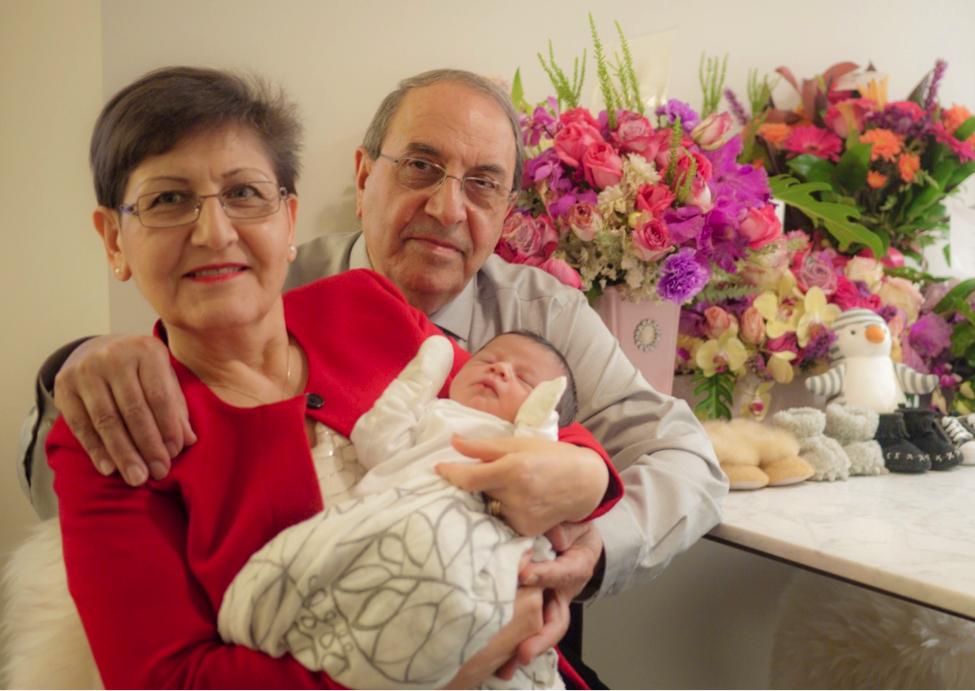
Ruhi and Aziz celebrated their 40th anniversary last fall by welcoming their first grandchild into the world.
After travelling the world together and completing their PhDs and postdoctoral fellowships, they eventually made their home in Vancouver, where Aziz became a faculty member in UBC’s Faculty of Medicine in 2005. In 2011, ICORD was happy to welcome Aziz and his wound healing lab to the Blusson Spinal Cord Centre.
One of the perks of being married work colleagues is the ability to share mutual excitement over their research findings. When Aziz finally isolated a molecule he had been searching for, he waited until lunchtime to announce his discovery so that he could share the findings with Ruhi.
According to the pair, there’s also a trust and understanding between them that can rarely be found between regular work colleagues. Knowing that his wife is the lab manager gives Aziz peace of mind. “I trust Ruhi with my lab management because I know she cares more than everyone,” he stated, “She understands my work situations and deadlines.”
Whether they are at home or in the lunchroom at the BSCC, their excitement for their research and their love for each other never wanes. “We have always been working together,” Ruhi said with a smile, “We will retire together.”
Their advice for couples who conduct research together? Aziz let us in on his secret: “If you’re colleagues, you have to be able to work together, not just at work, but at home… You need to trust each other to promote the aim of the research; both people need to be enthusiastic.”

. . .
. . . what they’re looking forward to about the upcoming ICORD Annual Research Meeting:

![]() I look forward to hearing from the speakers every year and seeing what everyone else at ICORD is up to. It’s like an annual update on what everyone is working on. I’m especially interested in seeing what the new ICORD principal investigators are studying!
I look forward to hearing from the speakers every year and seeing what everyone else at ICORD is up to. It’s like an annual update on what everyone is working on. I’m especially interested in seeing what the new ICORD principal investigators are studying!
![]() There are chances to see what possible collaborative opportunities exist with other researchers. It’s nice to brainstorm and get feedback from other people working on similar SCI models who can help give some insight on our data.
There are chances to see what possible collaborative opportunities exist with other researchers. It’s nice to brainstorm and get feedback from other people working on similar SCI models who can help give some insight on our data.
![]() I can’t wait to present my research on using vasopressor to increase blood flow and oxygen to minimize secondary damage after spinal cord injury!
I can’t wait to present my research on using vasopressor to increase blood flow and oxygen to minimize secondary damage after spinal cord injury!
![]() The Annual Research Meeting gives me a better sense of what goes on in the building, beyond what you see when you just walk past people’s labs. It’s great to interact with everyone at ICORD and listen to the invited speakers every year.
The Annual Research Meeting gives me a better sense of what goes on in the building, beyond what you see when you just walk past people’s labs. It’s great to interact with everyone at ICORD and listen to the invited speakers every year.

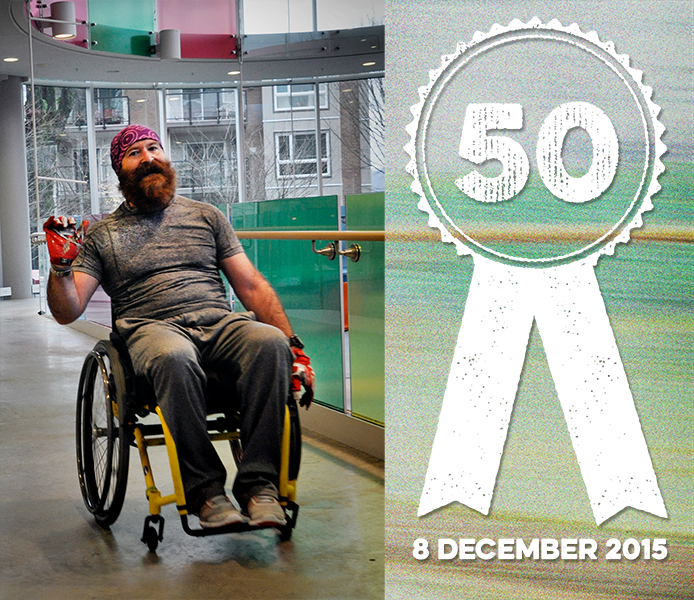
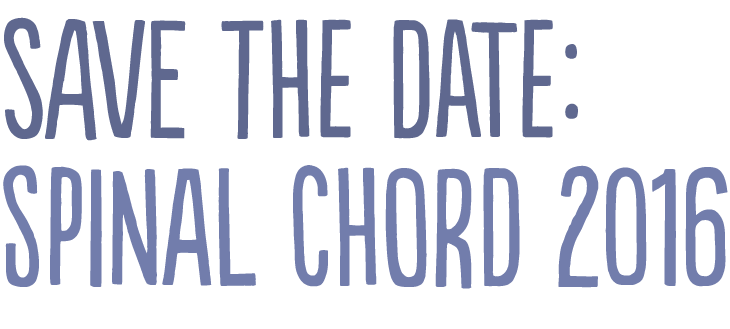
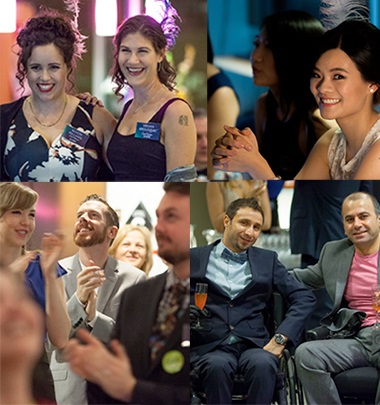

Can’t make it to the event but still want to support this great cause? You can donate online here.


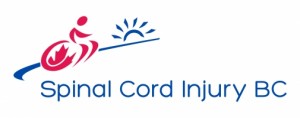
Spinal Cord Injury BC
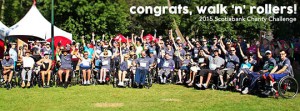 Support SCI-BC
Support SCI-BC
 Together we can create a healthier tomorrow through research
Together we can create a healthier tomorrow through research
The Vancouver Coastal Health Research Institute (VCHRI) is launching a research awareness campaign to promote and support research at VCH.
As part of the campaign, VCHRI is developing a monthly community newsletter, In It Together, which will bring attention to VCH clinical trials, research studies, and the essential role of the patient participants. The electronic newsletter aims to inspire interested individuals to find out more about research at VCH and participation opportunities by visiting vchri.ca/participate. Stories will feature clinical trials and studies at VCHRI and will highlight the potentially life-changing discoveries and the important role of volunteer participants.
We encourage you to sign up at vchri.ca/InItTogether and to help connect people you know to research. Together we will create a healthier tomorrow through research–be part of the discovery.

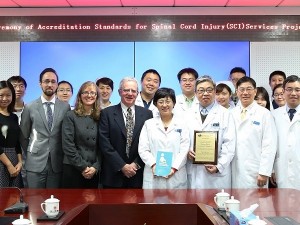 Canadian and Chinese experts begin work on implementing international best practices in spinal cord injury care
Canadian and Chinese experts begin work on implementing international best practices in spinal cord injury care
RHI’s Dr. Vanessa Noonan has joined Dr. Brian Wheelock of Accreditation Canada International (ACI) and Drs. Mouwang Zhou, Nan Liu and Fang Zhou of Peking University Third Hospital (PUTH) to present education sessions on SCI standards of excellence to PUTH staff in Beijing, China. Read more about this exciting international collaboration here.
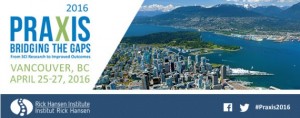
Praxis 2016
Hosted by the Rick Hansen Institute, this event will unite stakeholders from across the spinal cord injury (SCI) continuum and beyond to build awareness, share experiences, and workshop practical solutions to address the two translational “Valleys of Death”.
- Engage with leading SCI experts, community advocates, individuals with SCI, business leaders, policy makers, and regulators
- Participate in interactive panel and working sessions designed and facilitated by premier process consultants Stratchan Tomlinson
- Create action plans for moving past current barriers to the translation of scientific discoveries into practice and health policy
- Foster the sharing of real world experience by renowned healthcare innovators, leaders and champions, including unique perspectives from outside the SCI community
The preliminary program is now available! Check it out here.
The Call for Abstracts is now open! Deadline to submit a poster abstract is February 24, 2016. Read the submission guidelines.
Seats are limited to 200 participants to ensure everyone’s voice is heard.
Take advantage of the Early Bird registration discounts until February 29, 2016. Visit the Registration page for more information. www.praxis2016.com
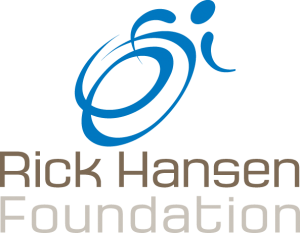 Rick Hansen Secondary School students visit Blusson Spinal Cord Centre
Rick Hansen Secondary School students visit Blusson Spinal Cord Centre
Grade Nine students from Rick Hansen Secondary School recently took part in an exciting new initiative in partnership with the Rick Hansen Foundation: a cross-curricular, project-based learning experience to explore disability.
The project kicked off with a visit to the Blusson Spinal Cord Centre. Tova Plashkes, the National Clinical Liaison at the Rick Hansen Institute, introduced students to spinal cord injury research. This was followed by an exciting tour of the centre’s ICORD research facilities. Students saw demonstrations of leading-edge rehabilitative technologies, explored the Human Locomotion Lab, and tried out equipment in the Physical Activity Research Centre.
 After Rick Hansen Ambassador, Robb Dunfield, offered students a glimpse into the personal side of disability, the students were asked to design a means of transport to allow a person with a mobility challenge to participate in an activity of their choice. Students worked in groups and presented their designs. The students did a terrific job, taking what they had learned in the morning and applying that knowledge in creating their innovative designs.
After Rick Hansen Ambassador, Robb Dunfield, offered students a glimpse into the personal side of disability, the students were asked to design a means of transport to allow a person with a mobility challenge to participate in an activity of their choice. Students worked in groups and presented their designs. The students did a terrific job, taking what they had learned in the morning and applying that knowledge in creating their innovative designs.
Perhaps the highest praise came from one student who described the opportunity to learn in this dynamic and different way as “life-changing and very inspirational.” The session was so successful that another 90 Rick Hansen School Secondary students visited the BSCC on February 17.
Special thanks to RHI and ICORD for making it such a great day for the students!
The Rick Hansen School Program works with schools across Canada to increase understanding of disability. For more information visit www.rickhansen.com.
UBC Young Women in Science & Engineering presents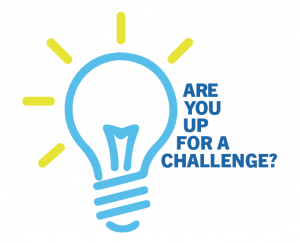
The 2016 Rick Hansen Access Innovation Competition
March 29 – 5:00-8:00 P.M.
Performance Theatre (The Nest, 2nd floor – 6133 University Blvd)
Free for students. Dinner is provided.
Undergraduate and graduate students are invited to an interactive evening of innovation, design, and talks from leading experts in entrepreneurship, access, health sciences research, and biomedical engineering. Competing students will be given an access challenge and present their solutions to a panel of experts. The winning team will be presented with the 2016 Rick Hansen Access Innovation Award and an opportunity to further develop their solution.
Register by Tuesday, March 16 to compete individually or as a team: click here
For more information contact: InnovationCompetition@outlook.com or call 604-716-0004.
This competition is brought to you by youngWISE.org, the Rick Hansen Foundation and the Neil Squire Society.

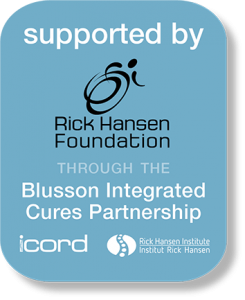 ICORD and the Rick Hansen Institute are working together to identify new treatments for SCI and apply existing treatments for other neurological disorders, injuries and diseases to SCI.
ICORD and the Rick Hansen Institute are working together to identify new treatments for SCI and apply existing treatments for other neurological disorders, injuries and diseases to SCI.
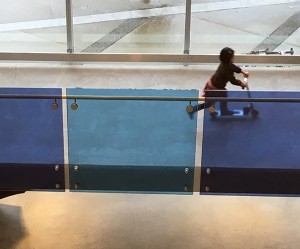
![]() This issues includes stories by Clarice Kwok, Simon Liem, Kay Leung, Ravina Johal & Cheryl Niamath. Photos courtesy of Greg Pearcey, Lowell McPhail, Jesse Read, Clarice Kwok, Ruhi Ghahary, Allie D., Victoria McCann, Lia Yu, Cheryl Niamath, Rick Hansen Foundation, Rick Hansen Institute, and SCI-BC.
This issues includes stories by Clarice Kwok, Simon Liem, Kay Leung, Ravina Johal & Cheryl Niamath. Photos courtesy of Greg Pearcey, Lowell McPhail, Jesse Read, Clarice Kwok, Ruhi Ghahary, Allie D., Victoria McCann, Lia Yu, Cheryl Niamath, Rick Hansen Foundation, Rick Hansen Institute, and SCI-BC.

